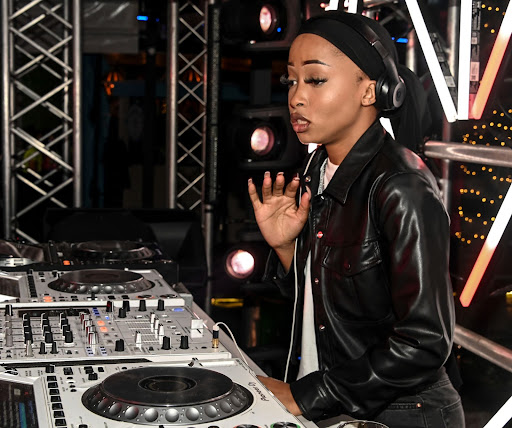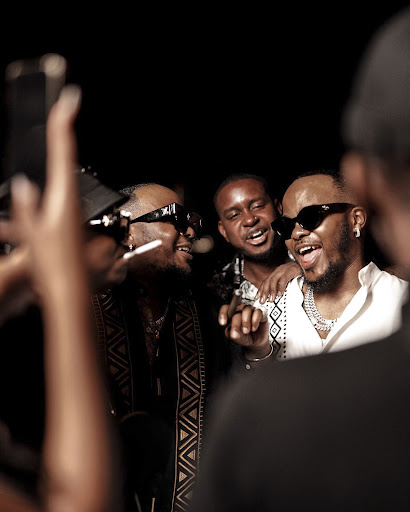Erasure: Lady Du says she appeared on a billboard in the US before she was ever profiled in a South African newspaper. (Oupa Bopape/Gallo Images)
In September, City Press journalist Phumlani S Langa berated amapiano artists for their lack of professionalism and disinterest in media platforms. “I see the whole amapiano thing dying out,” he wrote.
This was after Sir Trill, one of the genre’s most popular vocalists, failed to show up for his interview on Kaya FM. He found 9am too early for comfort. Langa said superstar producer Busta 929 had also stood City Press up while Uncle Vinny had given them “diva” attitude.
Langa isn’t alone. A number of journalists can attest to the inaccessibility of amapiano artists. And it’s not just traditional media that is having a hard time. The hosts of Podcast & Chill With MacG, a platform that has hosted several amapiano acts, expressed their frustration with the genre’s artists. “They think they’re superstars, like they’re the inventors of the industry; no one came before them, no one will come after them,” Sol Phenduka said and mentioned that Busta 929 had cancelled on them 45 minutes before his interview was supposed to take place.
Siya “Slikour” Metane echoed the same sentiments during a virtual discussion with artist Lady Du, pioneering producer duo MFR Souls, and DJ duo Major League DJz. “My worry is, if you look at the history of kwaito or gqom, it’s filled with people who are creating such great content, but they are not talking for it,” Slikour said after he had posed the question: “Why are amapiano producers media-shy?” MFR Souls’ response? “We are producers, we are so used to being behind the scenes.”
‘Blogs don’t matter’
Media is still crucial for documenting and contextualising art and culture, but, as a tool for exposure, which is the bottom line for most artists, traditional media is what border posts are to immigration. They exist and have a bit of control and command a certain level of authority. But a reasonable number of artists would rather slip through Beitbridge.
Today, songs stand a better chance of becoming hits via TikTok and Twitter than they do on radio and TV. In the Western world, blogs were pronounced dead years ago. The last nail in the coffin was the story of indie rapper Russ who, in 2017, told the popular music website Pigeons and Planes: “Blogs don’t matter.” This was after years of him emailing the website asking for coverage, to no avail. Russ eventually managed to crack it without the help of blogs.
Blogs aren’t obsolete yet, especially in Africa, but they are an optional step to an artist’s success.
 Twitter boost: DJ Uncle Waffles’ video of her dancing to a Young Stunna hit behind the decks gained her fame. Photo: (Oupa Bopape/Gallo Images)
Twitter boost: DJ Uncle Waffles’ video of her dancing to a Young Stunna hit behind the decks gained her fame. Photo: (Oupa Bopape/Gallo Images)
Amapiano’s latest viral sensation Uncle Waffles’ trajectory included no traditional media platform, not even blogs. The deejay blew up through a Twitter video of her getting down to Young Stunna’s now-hit Adiwele while behind the decks.
Streaming numbers may be increasing in South Africa, but MP3s are still in demand. The country’s high data costs means many people hold on to older technologies longer than those who are privileged. South African piracy websites such as Fakaza and Hip Hop Hub supply millions of fans with music they can’t afford or are reluctant to stream on Spotify and Apple Music. Contemporary Afro-soul artist Mnqobi Yazo said in an interview with ESAM that seeing his debut on Fakaza was tantamount to success.
That’s the ecosystem amapiano exists in. By now, you know the story of how DJs and producers got bookings through mixes and songs that were shared on WhatsApp and Facebook groups in the genre’s early stages before Yfm DJ Da Kruk played amapiano on the radio in the mid-2010s. Gqom’s story is similar, and the Durban genre was further enhanced by the taxi industry.
Late to the party
Traditional media is slow to adapt to trends. Media coverage for amapiano on traditional platforms was sparse even before artists became inaccessible superstars. “I was on a billboard in America before I could make it in a newspaper in South Africa,” Lady Du shared during talks with Slikour, Major League DJz and MFR Souls.
Major League DJz suggested a need for cultural material that adds to amapiano. “There needs to be a magazine, blogs. People don’t even know that [artists] are going overseas doing serious parties. If hip-hop [artists] were going to Zambia selling out shows, trust me, we would know about it. Amapiano deejays do that ‘every day but no one knows because there’s no journalism around amapiano.” Yet websites such as The Yanos Magazine and Zkhiphani cover amapiano almost daily, and journalists such as Madzadza Miya, Setumo-Thebe Mohlomi and Shiba Mazaza have written extensively about the genre on platforms like The Native, OkayAfrica, Music In Africa, Red Bull, New Frame and several others.
 Major League DJz believe more platforms should exist for the promotion of the yanos. (Photo: Facebook)
Major League DJz believe more platforms should exist for the promotion of the yanos. (Photo: Facebook)
The question that arises with their refusal to appreciate the few platforms is: who do these artists and industry insiders want to create these platforms? Slikour’s comments erase Vuma — A Music Revolution, a six-part documentary profiling the label Kalawa Jazmee that aired on SABC 1 in 2009. He overlooked Sihle Mthembu and Esinako Ndabeni’s 2018 book Born to Kwaito, which does a great job archiving the genre.
In November, amapiano super-producer Kabza De Small broke down the origins of amapiano during an interview with dance music veteran Oskido in his Joy Ride With Oskido YouTube show. Kabza De Small pointed out that amapiano started when DJs in the townships played kwaito songs at a slow tempo. People got so used to it through mixtapes that the producers started making songs in that tempo. “First it was remixes, and then [producer] Mdu [aka TRP] came up with the log drum. Amapiano has always been there, but Mdu is the one who came up with the log drum sound,” he said.
Passive exclusion
Although Kabza De Small seemed comfortable breaking bread with the OG, the mainstream media space has proven hostile towards artists, though passively. A good example is De Mthuda and Njelic’s interview on eNCA in 2019. There to discuss their mega-hit Shesha, the two artists, especially De Mthuda, didn’t seem comfortable expressing themselves purely in English. When De Mthuda appeared on Idols South Africa, there were concerns about the show’s host, ProVerb, interviewing him in English.
One viewer tweeted, “ProVerb should stop interviewing De Mthuda in English. He is now giving calculated answers and he looks and feels uncomfortable.”
Shaya!, a documentary by filmmaker and hip-hop deejay Papercutt released in 2019, sees amapiano artists such as Kabza De Small, MFR Souls and JazziDisciples speak freely and appear comfortable.
Papercutt states it was initially challenging to get hold of the subjects. “At first, I thought they were protecting the culture from being infiltrated and I honestly thought they were acting like celebrities,” Papercutt says.
“There’s a lot of key pioneers that we were supposed to interview but didn’t take us seriously cause we were not representing a national TV broadcaster.”
It was only after Papercutt and his team were involved in the Corona Amapiano Sunsets Tour that they were allowed into the world of the yanos. “That’s when we were able to really form relationships with everybody,” he says. “And after talking to them individually, I realised that these guys are all actually humble guys… ke majita a ko kasi a grand, it’s just that the industry used to diss amapiano so bad and sideline them.”
The divide between mainstream media and amapiano artists is of both parties’ making. It would be great for media platforms to open up to covering emerging subcultures before they become prominent. And although it’s great that artists enjoy having conversations with each other, it’s equally important that they talk to the media and open themselves to external scrutiny.